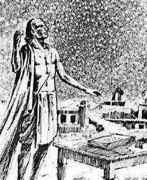Person: Aryabhata The Elder

Aryabhata I was an Indian mathematician who wrote the Aryabhatiya which summarises Hindu mathematics up to that 6th Century.
Mathematical Profile (Excerpt):
- Al-Biruni has not helped in understanding Aryabhata's life, for he seemed to believe that there were two different mathematicians called Aryabhata living at the same time.
- He therefore created a confusion of two different Aryabhatas which was not clarified until 1926 when B Datta showed that al-Biruni's two Aryabhatas were one and the same person.
- We know the year of Aryabhata's birth since he tells us that he was twenty-three years of age when he wrote Aryabhatiya Ⓣ(The work of Aryabhata) which he finished in 499.
- We have given Kusumapura, thought to be close to Pataliputra (which was refounded as Patna in Bihar in 1541), as the place of Aryabhata's birth but this is far from certain, as is even the location of Kusumapura itself.
- We do know that Aryabhata wrote Aryabhatiya Ⓣ(The work of Aryabhata) in Kusumapura at the time when Pataliputra was the capital of the Gupta empire and a major centre of learning, but there have been numerous other places proposed by historians as his birthplace.
- However, giving Asmaka as Aryabhata's birthplace rests on a comment made by Nilakantha Somayaji in the late 15th century.
- Pataliputra, being the capital of the Gupta empire at the time of Aryabhata, was the centre of a communications network which allowed learning from other parts of the world to reach it easily, and also allowed the mathematical and astronomical advances made by Aryabhata and his school to reach across India and also eventually into the Islamic world.
- As to the texts written by Aryabhata only one has survived.
- Aryabhata was an author of at least three astronomical texts and wrote some free stanzas as well.
- The surviving text is Aryabhata's masterpiece the Aryabhatiya Ⓣ(The work of Aryabhata) which is a small astronomical treatise written in 118 verses giving a summary of Hindu mathematics up to that time.
- The Aryabhatiya Ⓣ(The work of Aryabhata) contains an introduction of 10 verses, followed by a section on mathematics with, as we just mentioned, 33 verses, then a section of 25 verses on the reckoning of time and planetary models, with the final section of 50 verses being on the sphere and eclipses.
- We said that the first section had ten verses and indeed Aryabhata titles the section Set of ten giti stanzas.
- Van der Waerden suggests that three verses have been added and he identifies a small number of verses in the remaining sections which he argues have also been added by a member of Aryabhata's school at Kusumapura.
- The mathematical part of the Aryabhatiya Ⓣ(The work of Aryabhata) covers arithmetic, algebra, plane trigonometry and spherical trigonometry.
- First we look at the system for representing numbers which Aryabhata invented and used in the Aryabhatiya Ⓣ(The work of Aryabhata).
- it is extremely likely that Aryabhata knew the sign for zero and the numerals of the place value system.
- Next we look briefly at some algebra contained in the Aryabhatiya Ⓣ(The work of Aryabhata).
- Aryabhata uses the kuttaka method to solve problems of this type.
- Aryabhata gave an accurate approximation for π.
- There are reasons to believe that Aryabhata devised a particular method for finding this value.
- It is shown with sufficient grounds that Aryabhata himself used it, and several later Indian mathematicians and even the Arabs adopted it.
- The conjecture that Aryabhata's value of π is of Greek origin is critically examined and is found to be without foundation.
- Aryabhata discovered this value independently and also realised that π is an irrational number.
- Thus the credit of discovering this exact value of π may be ascribed to the celebrated mathematician, Aryabhata I.
- We now look at the trigonometry contained in Aryabhata's treatise.
- Other rules given by Aryabhata include that for summing the first nnn integers, the squares of these integers and also their cubes.
- Aryabhata gives formulae for the areas of a triangle and of a circle which are correct, but the formulae for the volumes of a sphere and of a pyramid are claimed to be wrong by most historians.
- Without some supporting evidence that these technical terms have been used with these different meanings in other places it would still appear that Aryabhata did indeed give the incorrect formulae for these volumes.
- We have looked at the mathematics contained in the Aryabhatiya Ⓣ(The work of Aryabhata) but this is an astronomy text so we should say a little regarding the astronomy which it contains.
- Aryabhata gives a systematic treatment of the position of the planets in space.
Born 476, Kusumapura (now Patna), India. Died 550, India.
View full biography at MacTutor
Tags relevant for this person:
Analysis, Ancient Arab, Ancient Babylonian, Ancient Indian, Astronomy, Geometry, Origin India, Special Numbers And Numerals
Thank you to the contributors under CC BY-SA 4.0! 

- Github:
-

- non-Github:
- @J-J-O'Connor
- @E-F-Robertson
References
Adapted from other CC BY-SA 4.0 Sources:
- O’Connor, John J; Robertson, Edmund F: MacTutor History of Mathematics Archive
